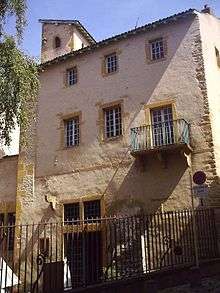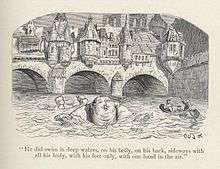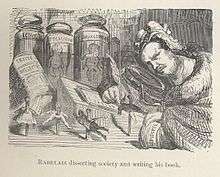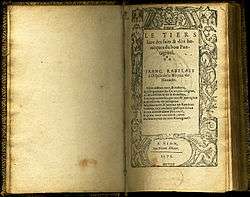François Rabelais
| François Rabelais | |
|---|---|
 | |
| Born |
Between 1483 and 1494 Chinon Kingdom of France |
| Died |
9 April 1553 Paris Kingdom of France |
| Occupation | Writer, physician, humanist |
| Nationality | French |
| Alma mater |
University of Poitiers University of Montpellier |
| Literary movement | Renaissance humanism |
| Notable works | Pantagruel, Gargantua |
François Rabelais (/ˌræbəˈleɪ/;[1] French: [fʁɑ̃.swa ʁa.blɛ]; between 1483 and 1494 – 9 April 1553) was a French Renaissance writer, humanist, physician, Renaissance humanist, monk and Greek scholar. He has historically been regarded as a writer of fantasy, satire, the grotesque, bawdy jokes and songs. His best known work is Gargantua and Pantagruel. Because of his literary power and historical importance, Western literary critics consider him one of the great writers of world literature and among the creators of modern European writing.[2] His literary legacy is such that today, the word Rabelaisian has been coined as a descriptive inspired by his work and life. Merriam-Webster defines the word as describing someone or something that is "marked by gross robust humor, extravagance of caricature, or bold naturalism."[3]
Biography
No reliable documentation of the place or date of the birth of François Rabelais has survived. While some scholars put the date as early as 1483, he was probably born in November 1494 near Chinon in the province of Touraine, where his father worked as a lawyer.[4][5] The estate of La Devinière in Seuilly in the modern-day Indre-et-Loire, allegedly the writer's birthplace, houses a Rabelais museum.
Rabelais became a novice of the Franciscan order, and later a friar at Fontenay-le-Comte in Poitou, where he studied Greek and Latin as well as science, philology, and law, already becoming known and respected by the humanists of his era, including Guillaume Budé (1467-1540). Harassed due to the directions of his studies, Rabelais petitioned Pope Clement VII (in office 1523-1534) and gained permission to leave the Franciscans and to enter the Benedictine order at Maillezais in Poitou, where he was more warmly received.[6]

Later he left the monastery to study medicine at the University of Poitiers and at the University of Montpellier. In 1532 he moved to Lyon, one of the intellectual centres of France, and not only practiced medicine but edited Latin works for the printer Sebastian Gryphius (ca 1492-1556). From 1540, François Rabelais came to Gryphius to publish his translations of Hippocrates, Galen and Giovanni Mainardi. As a physician, he used his spare time to write and publish humorous pamphlets which were critical of established authority and stressed his own perception of individual liberty.
Using the pseudonym Alcofribas Nasier (an anagram of François Rabelais minus the cedille on the c), in 1532 he published his first book, Pantagruel, that would become the first of his Gargantua series. In this book, Rabelais sings the praises of the wines from his hometown of Chinon through vivid descriptions of the "eat, drink and be merry" lifestyle of the main character, Pantagruel, and of his friends. Despite the popularity of his book, both it and his prequel book (1534) on the life of Pantagruel's father Gargantua were condemned by the academics at the Sorbonne for their unorthodox ideas and by the Roman Catholic Church for their derision of certain religious practices. Rabelais's third book, published under his own name in 1546, was also banned.
With support from members of the prominent du Bellay family, Rabelais received approval from King François I to continue to publish his collection. However, after the king's death in 1547, the academic élite frowned upon Rabelais, and the French Parlement suspended the sale of his fourth book (published in 1552).
Rabelais traveled frequently to Rome with his friend Cardinal Jean du Bellay, and lived for a short time in Turin (1540- ) as part of the household of du Bellay's brother, Guillaume, while François I was his patron. Rabelais probably spent some time in hiding, threatened by being labeled a heretic. Only the protection of du Bellay saved Rabelais after the condemnation of his novel by the Sorbonne. Du Bellay would again help Rabelais in 1540 by seeking a papal authorization to legitimize two of his children (Auguste François, father of Jacques Rabelais, and Junie). Rabelais taught medicine at Montpellier in 1534 and in 1539.
In June 1543 Rabelais became Master of Requests.[7]
Between 1545 and 1547 François Rabelais lived in Metz, then a free imperial city and a republic, to escape the condemnation by the University of Paris. In 1547, he became curate of Saint-Christophe-du-Jambet in Maine and of Meudon near Paris, from which he resigned in January 1553 before his death in Paris in April 1553.
Different accounts survive of Rabelais' death and of his last words. According to some, he wrote a famous one sentence will: "I have nothing, I owe a great deal, and the rest I leave to the poor", and his last words were "I go to seek a Great Perhaps." One "last words" reference work provides at least four distinct versions of his last words (and additional variations of these). While many accounts feature the phrase "un grand peut-être" ("a Great Perhaps") – all are listed as "doubtful" due to lack of documentation. Additionally, some sources examined for Rabelais' last words cite Cardinal du Bellay; others cite Cardinal de Chatillon, creating further confusion.[8]
Gargantua and Pantagruel


Gargantua and Pantagruel tells the story of two giants—a father, Gargantua, and his son, Pantagruel—and their adventures, written in an amusing, extravagant, and satirical vein.
While the first two books focus on the lives of the two giants, the rest of the series is mostly devoted to the adventures of Pantagruel's friends – such as Panurge, a roguish, erudite maverick, and Brother Jean, a bold, voracious and boozing ex-monk – and others on a collective naval journey in search of the Divine Bottle.
Even though most chapters are humorous, wildly fantastic and sometimes absurd, a few relatively serious passages have become famous for descriptions of humanistic ideals of the time. In particular, the letter of Gargantua to Pantagruel and the chapters on Gargantua's boyhood present a rather detailed vision of education.
Thélème
It is in the first book that Rabelais writes of the Abbey of Thélème, built by the giant Gargantua. It differs remarkably from the monastic norm, as the abbey has a swimming pool, maid service, and no clocks in sight.
One of the verses of the inscription on the gate to the Abbey says:
Grace, honour, praise, delight,
Here sojourn day and night.
Sound bodies lined
With a good mind,
Do here pursue with might
Grace, honour, praise, delight.

Rabelais gives us a description of the way of life of the Thélèmites of the abbey and their rule:
All their life was spent not in laws, statutes, or rules, but according to their own free will and pleasure. They rose out of their beds when they thought good; they did eat, drink, labour, sleep, when they had a mind to it and were disposed for it. None did awake them, none did offer to constrain them to eat, drink, nor to do any other thing; for so had Gargantua established it. In all their rule and strictest tie of their order there was but this one clause to be observed,because men that are free, well-born, well-bred, and conversant in honest companies, have naturally an instinct and spur that prompteth them unto virtuous actions, and withdraws them from vice, which is called honour. Those same men, when by base subjection and constraint they are brought under and kept down, turn aside from that noble disposition by which they formerly were inclined to virtue, to shake off and break that bond of servitude wherein they are so tyrannously enslaved; for it is agreeable with the nature of man to long after things forbidden and to desire what is denied us.[9]
- Do What Thou Wilt;
Use of language
The French Renaissance was a time of linguistic controversies. Among the issues debated by scholars was the question of the origin of language. What was the first language? Is language something that all humans are born with or something that they learn? Is there some sort of connection between words and the objects they refer to, or are words purely arbitrary? Rabelais deals with these matters, among many others, in his books.
The early 16th century was also a time of innovations and change for the French language, especially in its written form. The first book of French grammar was published in 1530, followed nine years later by the language's first dictionary. Since spelling was far less codified than it is now, each author used his own orthography. Rabelais himself developed a personal set of rather complex rules. He was a supporter of etymological spelling, i.e., one that reflects the origin of words, and was thus opposed to those who favoured a simplified spelling, one that reflects the pronunciation of words.
Rabelais' use of his native tongue was original, lively, and creative. He introduced dozens of Greek, Latin, and Italian loan-words and direct translations of Greek and Latin compound words and idioms into French. He also used many dialectal forms and invented new words and metaphors, some of which have become part of the standard language and are still used today.
His works are also known for being filled with sexual double-entendres, dirty jokes, and bawdy songs.
Views
Most scholars today agree that the French author wrote from a perspective of Christian humanism.[10] This has not always been the case. Abel Lefranc, in his 1922 introduction to Pantagruel, depicted Rabelais as a militant anti-Christian atheist.[11] M. A. Screech opposed this view and interpreted Rabelais as an Erasmian Christian humanist, the view that commands majority support today.[12]
Rabelais was Roman Catholic. Timothy Hampton writes that "to a degree unequaled by the case of any other writer from the European Renaissance, the reception of Rabelais's work has involved dispute, critical disagreement, and ... scholarly wrangling ..."[13] But at present, "whatever controversy still surrounds Rabelais studies can be found above all in the application of feminist theories to Rabelais criticism".[14]
In literature
| French literature |
|---|
| by category |
| French literary history |
| French writers |
|
| Portals |
|
In his novel Tristram Shandy, Laurence Sterne quotes extensively from Rabelais.
Alfred Jarry performed, from memory, hymns of Rabelais at Symbolist Rachilde's Tuesday salons. Jarry worked for years on an unfinished libretto for an opera by Claude Terrasse based on Pantagruel.[15]
Anatole France lectured on him in Argentina. John Cowper Powys, D. B. Wyndham-Lewis, and Lucien Febvre (one of the founders of the French historical school Annales) wrote books about him. Mikhail Bakhtin, a Russian philosopher and critic, derived his celebrated concept of the carnivalesque and grotesque body from the world of Rabelais.
Hilaire Belloc was a great admirer of Rabelais. He praised him as "at the summit" of authors of fantastic books.[16] He also wrote a short story entitled "On the Return of the Dead" in which Rabelais descended from heaven to earth in 1902 to give a lecture in praise of wine at the London School of Economics, but was instead arrested.[17]
Mikhail Bakhtin wrote Rabelais and His World, praising the author for understanding and unbridled embrace of the carnival grotesque. In the book he analyzes Rabelais's use of the carnival grotesque throughout his writings and laments the death of the purely communal spirit and regenerating laughter of the carnival in modern culture.
George Orwell was not an admirer of Rabelais. Writing in 1940, he called him "an exceptionally perverse, morbid writer, a case for psychoanalysis".[18]
Milan Kundera, in a 2007 article in The New Yorker, wrote: "(Rabelais) is, along with Cervantes, the founder of an entire art, the art of the novel." (page 31). He speaks in the highest terms of Rabelais, calling him "the best", along with Flaubert.
Rabelais was a major reference point for a few main characters (Boozing wayward monks, University Professors, and Assistants) in Robertson Davies's novel The Rebel Angels, part of the The Cornish Trilogy. One of the main characters in the novel, Maria Theotoky, writes her PhD on the works of Rabelais, while a murder plot unfolds around a scholarly unscathed manuscript. Rabelais was also mentioned in Davies's books The Lyre of Orpheus, and Tempest-Tost.
Rabelais is highlighted as a pivotal figure in Kenzaburō Ōe's acceptance speech for the Nobel Prize in Literature in 1994.[19]
Henry Miller, in his first novel, Tropic of Cancer, speaks admiringly of Rabelais in several passages.
Honours, tributes and legacy
- The public university in Tours, France is named Université François Rabelais.
- Honoré de Balzac was inspired by the works of Rabelais to write Les Cent Contes Drolatiques (The Hundred Humorous Tales). Balzac also pays homage to Rabelais by quoting him in more than twenty novels and the short stories of La Comédie humaine (The Human Comedy). Michel Brix wrote of Balzac that he "is obviously a son or grandson of Rabelais... He has never hidden his admiration for the author of Gargantua that he cites in Le Cousin Pons as "the greatest mind of modern humanity".[20][21] In his story of Zéro, Conte Fantastique published in La Silhouette on 3 October 1830, Balzac even adopted Rabelais's pseudonym (Alcofribas).
- Rabelais also left a tradition at the University of Montpellier's Faculty of Medicine: no graduating medic can undergo a convocation without taking an oath under Rabelais's robe. Further tributes are paid to him in other traditions of the university, such as its faluche, a distinctive student headcap styled in his honour with four bands of colour emanating from its centre.
- Asteroid '5666 Rabelais' was named in honor of François Rabelais in 1982.[22]
- In its 26 August 2009 obituary for Sen. Edward M. Kennedy, the New York Times described the late Senator as a "Rabelaisian figure in the Senate and in life".[23]
- In Jean-Marie Gustave Le Clézio's 2008 Nobel Prize lecture, Le Clézio referred to Rabelais as "....the greatest writer in the French language".
- In the present day Rabelais can be found basking under the shade of a hackberry tree. The Jardin des Plantes in Montpellier has a statue of him, which watches over hundreds of species in the botanical garden.
- In France the moment at a restaurant when the waiter presents the bill is still sometimes called le quart d'heure de Rabelais, in memory of a famous trick Rabelais used to get out of paying a tavern bill when he had no money.[24]
Works
- Gargantua and Pantagruel, a series of four or five books including:
- Pantagruel (1532)
- La vie très horrifique du grand Gargantua, usually called Gargantua (1534)
- Le Tiers Livre ("The third book", 1546)
- Le Quart Livre ("The fourth book", 1552)
- Le Cinquiesme Livre (A fifth book, whose attribution to Rabelais is debated)
See also
References
- Notes
- ↑ "Rabelais, François". The American Heritage New Dictionary of Cultural Literacy.
- ↑ Mihail Mihajlovič Bakhtin (1984). Rabelais and His World. Indiana University Press. pp. 1–2. ISBN 978-0-253-20341-0. Retrieved 6 January 2013.
- ↑ "Rabelaisian". Merriam-Webster.
- ↑ The Rabelais Encyclopedia, p. xiii
- ↑ "Rabelais, François". The Columbia Encyclopedia, Sixth Edition. 2001–07. Retrieved 27 May 2008.
- ↑ Febvre, Lucien (1982). The Problem of Unbelief in the Sixteenth Century, the Religion of Rabelais. Harvard College. p. 264. ISBN 0-674-70825-3.
- ↑ Marichal, Robert (1948). "Rabelais fût il Maître des Requêtes?". Bibliothèque d'Humanisme et Renaissance. 10: 169–178, at p. 169. JSTOR 20673434. (registration required (help)).
- ↑ Brahms, William B. (2010). Last Words of Notable People: Final Words of More than 3500 Noteworthy People Throughout History. Haddonfield, NJ: Reference Desk Press. p. 523. ISBN 978-0-9765325-2-1.
- ↑ Rabelais, François. Gargantua and Pantagruel. Everyman's Library. ISBN 978-0-679-43137-4
- ↑ Bowen 1998
- ↑ Davis, Natalie Zemon. "Beyond Babel" in Davis & Hampton, "Rabelais and His Critics". Occasional Papers Series, University of California Press.
- ↑ Screech 1979, p. 14
- ↑ Hampton, Timothy. "Language and Identities" in Davis & Hampton, "Rabelais and His Critics". Occasional Papers Series, University of California Press.
- ↑ Bruno Braunrot, "Critical Theory" entry in The Rabelais Encyclopedia. p. 45.
- ↑ Fisher, Ben (2000). The Pataphysician's Library: An Exploration of Alfred Jarry's Livres Pairs. Liverpool University Press. pp. 95–98. ISBN 9780853239260.
- ↑ Belloc, Hilaire. On Everything, E.P. Dutton and Company, 1910, p.239.
- ↑ Belloc, Hilaire. On Nothing and Kindred Subjects, Methuen and Co, 1908, pp.89-98.
- ↑ Cohen, Albert, "Review of Nailcruncher", The Collected Essays, Journalism and Letters of George Orwell, Vol. 2
- ↑ Ōe lecture, NobelPrize.org, 1994.
- ↑ Bibliothèque de la Pleiade, 1977, t.VII, p.587
- ↑ Michel Brix,Balzac and the Legacy of Rabelais, PUF, 2002–2005, vol. 102, p.838
- ↑ Schmadel, Lutz D.; International Astronomical Union (2003). Dictionary of minor planet names. Berlin; New York: Springer-Verlag. p. 480. ISBN 978-3-540-00238-3. Retrieved 9 September 2011.
- ↑ Broder, 26 August 2009.
- ↑ Brillat-Savarin, Anthelme, La Physiologie du Gout, Meditiation 28.
- Bibliography
- Auden, W.H.; Kronenberger, Louis (1966), The Viking Book of Aphorisms, New York: Viking Press
- Bakhtin, Mihail, Tapani Laine, Paula Nieminen, and Erkki Salo. François Rabelais: Keskiajan Ja Renessanssin Nauru. Helsinki: Like, 1968.
- Bakhtin, M. M. [1941, 1965] Rabelais and His World. Trans. Hélène Iswolsky. Bloomington: Indiana University Press, 1993
- Bodemer, Brett: "Pantagruel's Seventh Chapter:The Title as Suspect Codpiece."
- Bowen, Barbara C. (1998). Enter Rabelais, Laughing. Vanderbilt University Press. ISBN 0-8265-1306-9.
- Brahms, William B. (2010). Last Words of Notable People: Final Words of More than 3500 Noteworthy People Throughout History. Haddonfield, NJ: Reference Desk Press. ISBN 978-0-9765325-2-1.
- Broder, John M. Edward Kennedy, Senate Stalwart, Dies, The New York Times, 26 August 2009. Retrieved 2009-08-26.
- Del Campo, Gerald. Rabelais: The First Thelemite. The Order of Thelemic Knights.
- Dixon, J.E.G. & John L. Dawson. Concordance des Oeuvres de François Rabelais. Geneva: Librairie Droz, 1992.
- Febvre, Lucien. Gottlieb, Beatrice trans. The Problem of Unbelief in the Sixteenth Century: The Religion of Rabelais (Cambridge: Harvard University Press, 1982).
- Langer, Ullrich, "Charity and the Singular: The Object of Love in Rabelais," in: Nominalism and Literary Discourse, ed. Hugo Keiper, Christoph Bode, and Richard Utz (Amsterdam: Rodopi, 1997), pp. 217–26.
- Lee, Jae Num. "Scatology in Continental Satirical Writings from Aristophanes to Rabelais" and "English Scatological Writings from Skelton to Pope." Swift and Scatological Satire. Albuquerque: U of New Mexico P, 1971. 7–22; 23–53.
- Screech, M.A. (1979). Rabelais. London: Duckworth. ISBN 0-7156-1660-9.
External links
- Works by François Rabelais at Project Gutenberg
- Works by or about François Rabelais at Internet Archive
- Works by François Rabelais at LibriVox (public domain audiobooks)

- Project Gutenberg e-text of Gargantua and Pantagruel
- Association de Bibliophiles Universels e-text of Gargantua in French
- A Dutch website about Rabelais
- Rabelais et la Renaissance, sur le Portail de la Renaissance française (French)
- François Rabelais Museum on the Internet (French)
- Henry Émile Chevalier, Rabelais and his editors, 1868 (French).